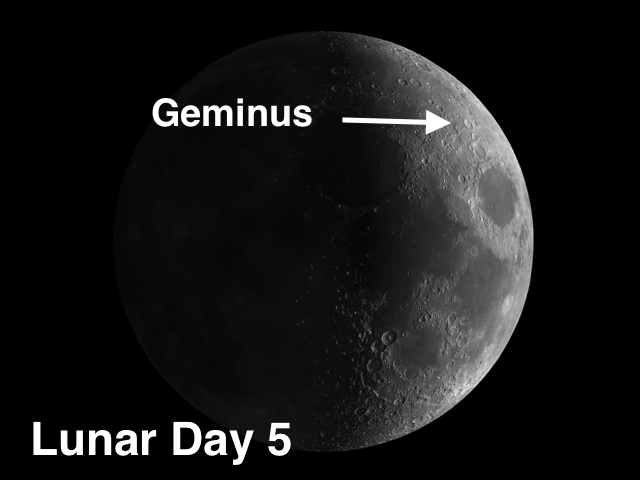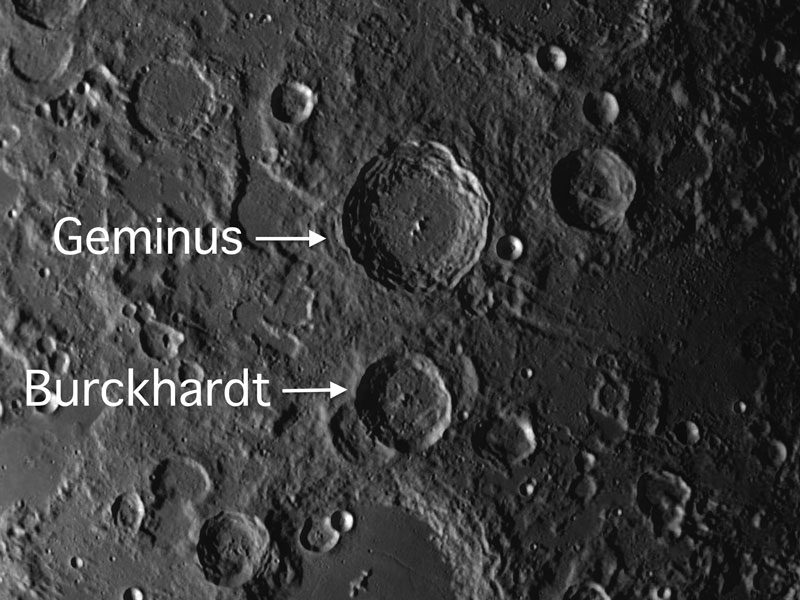 The week of April 24-30 takes us from lunar Day 28 through the end of Day 5. This week we will highlight the crater Geminus, visible on Saturday.
The week of April 24-30 takes us from lunar Day 28 through the end of Day 5. This week we will highlight the crater Geminus, visible on Saturday.
 Geminus: [NE/F15] Roughly 200 miles north of Mare Crisium* you will find the moderately complex 55-mile crater Geminus. It has terraced walls and small central peaks. This will give you an indication of what to start looking for in the following days as craters become increasingly more complex.
Geminus: [NE/F15] Roughly 200 miles north of Mare Crisium* you will find the moderately complex 55-mile crater Geminus. It has terraced walls and small central peaks. This will give you an indication of what to start looking for in the following days as craters become increasingly more complex.
OF ADDITIONAL INTEREST IN SPACE THE WEEK OF APRIL 24-30 – ARCTURUS:
Take a look at the bright star Arcturus, high in the east at the end of civil twilight. It is the fourth brightest star in the heavens and was put to interesting use during the 1933 World’s Fair in Chicago. Shortly before the fair, astronomers had estimated the distance of Arcturus to be 40 light years, and since it had been 40 years since the First World’s Fair in 1893, they hit upon the bright idea of using the light that left Arcturus during the First World’s Fair (which would be arriving just in time) to light up the 40th World’s Fair! At the time, the newly invented photocell, which uses light to generate electricity, was all the rage, so the light that emanated from Arcturus during the First World’s Fair was used. At the appointed hour, light from Arcturus was captured by a telescope at the University of Chicago which was then directed onto a photo cell which turned on the lights at the 40th World’s Fair.
As an interesting aside, at a distance of 40 light years, we receive the same amount of heat from Arcturus as we would from a candle placed five miles away!
======================
It is highly recommended that you get a copy of Sky and Telescope’s Field Map of the Moon, the very finest Moon map available for use at the telescope. It is available for $10.95 at www.skyandtelescope.com and on Amazon. All features mentioned in this blog will be keyed to the grid on the Field Map and will look like this: Plato: [NW/D9]
Credits:
Courtesy of Gray Photography of Corpus Christi, Texas
Lunar photos: NASA / USGS / BMDO / LROC / ASU / DLR / LOLA / Moon Globe. Used by permission
- Rupes Cauchy: A Best Known Fault on the Moon - July 22, 2024
- Moon Crater Schickard – Crater Floor has Stripes - July 15, 2024
- Moon Craters Langrenus and Vandelinus - July 8, 2024
